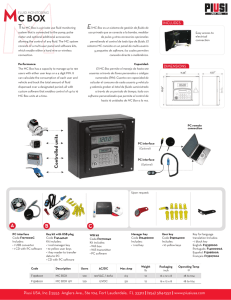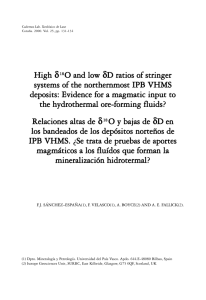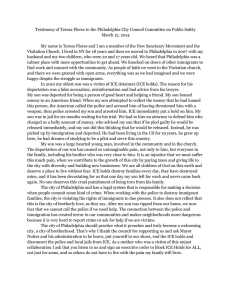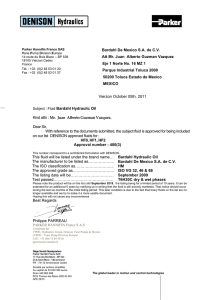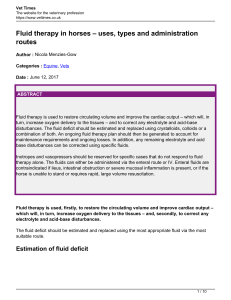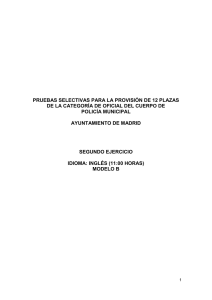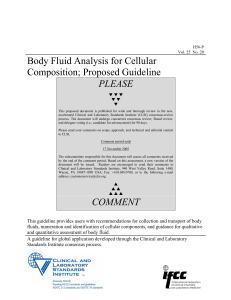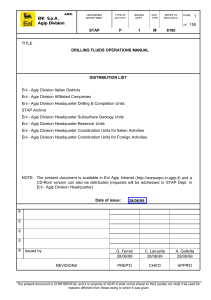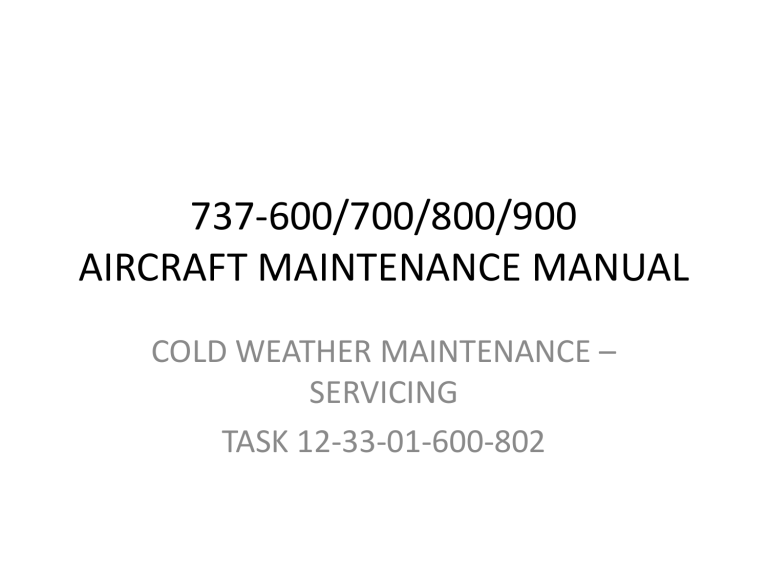
737-600/700/800/900 AIRCRAFT MAINTENANCE MANUAL COLD WEATHER MAINTENANCE – SERVICING TASK 12-33-01-600-802 General • This procedure gives data for removal of ice, snow, slush and frost from the airplane. • This procedure also gives data for the prevention of subsequent accumulation of ice, snow, slush and frost. • It also includes other related data for the operation of the airplane in cold weather. • Use the data that follow to make sure the procedures are satisfactory: (a) Previous weather conditions. (b) The equipment or materials that are available. (c) The weather conditions at the airport where you will operate. • Low temperatures (below freezing) can affect grease viscosity. • Lubricate landing gear and flight control components in warm weather prior to cold weather ground operations or in a heated hangar. (a) If lubrication must be accomplished in cold weather, warm air or electric heat blankets can be used to heat the components and the grease gun. (b) For the landing gear, an enclosure can be fabricated around the strut to make the heating more efficient. (c) Do not apply heat directly to tires. Definitions • Ground-Accumulated Ice Ice that has accumulated on the fan blades while the airplane has been on the ground for a prolonged stop, such as a plane that has been parked overnight. Ground-Accumulated Ice must be removed before engine start. • Operational Ice Ice that has accumulated on the fan blades while the engine is running at idle. Operational Ice is allowed before departure because it can be removed by engine runups during taxi-out. • Deicing Procedure to remove the frost, ice or snow from the airplane. Hot water or a hot mixture of water and deicing/anti-icing fluid is applied. Alternate methods of deicing are forced air and infrared deicing. Refer to FAA Notice 8000.XXX for the current winter season, which includes industry information on these alternate methods. • Anti-icing Procedure to make sure that ice, snow and/or frost does not collect and become attached to the airplane surfaces. Anti-icing fluid or a mixture of anti-icing fluid and water is applied to the airplane. • One step ice removal/anti-icing Procedure that applies a hot deicing/anti-icing fluid or mixture of fluid and water. Use the conditions that follow to make a decision on how hot to make the fluid or the fluid and water mixture: 1) The ambient temperature 2) The weather conditions • Two step ice removal/anti-icing Procedure that has the steps that follow: 1) Apply hot water or a hot mixture of deicing/anti-icing fluid and water to remove the ice. 2) Immediately follow with a spray of a deicing/anti-icing fluid or a mixture of deicing/antiicing fluid and water for anti-icing. This step must be done less than 3 minutes after you started the first step. If it is necessary, do the procedure area by area. • Holdover time Is the approximate time anti-icing fluid will keep the frost, ice, or snow off the airplane surfaces that have protection. NOTE: You cannot find the level of protection or the holdover time with precision. The weather conditions and the fluid/fluid mixture will have an effect on the holdover time. Refer to FAA Notice 8000.XXX for the current winter season. This document includes tables for holdover times for all commercially available deicing fluids that have been certified for the current winter season. WARNING: USE THE CORRECT EQUIPMENT FOR EACH TYPE OF FLUID. THE INCORRECT EQUIPMENT WILL DECREASE THE TIME THAT THE FLUID WILL PREVENT ICE. ICE CAN PREVENT THE FREE MOVEMENT OF FLIGHT CONTROL SURFACES. THIS CAUSES A DANGEROUS CONDITION DURING FLIGHT. • Type I deicing/anti-icing fluids Type I (not thickened) deicing/anti-icing fluids usually have a minimum of 80 percent Glycol. The temperature makes the viscosity change, but the shear stress does not change. These fluids give anti-icing protection for only a short time. • Type II, Type III and Type IV deicing/anti-icing fluids This fluids usually have a minimum of 50 percent Glycol. There is also 45 to 50 percent water plus thickeners and inhibitors. The temperature and the shear stress that is applied can make the viscosity of these fluids change. They are usually very viscous at low levels of shear stress. When the shear stress changes, their viscosity decreases very quickly. This fluids give longer holdover times than Type I deicing/anti-icing fluids. WARNING: KEEP WATER OUT OF THE STATIC PORTS. WATER CAN FREEZE AND CAUSE A BLOCKAGE OF THE PORTS. ICE IN THE STATIC PORTS IS DANGEROUS DURING FLIGHT. • An airplane that is parked, for this cold weather procedure, is an airplane in the loading area for a short time to be prepared for the departure. • Cold weather operation does not include an airplane that is parked for a long time. If the airplane has been parked for a long time, do this task: Put the Airplane Back to A Serviceable Condition After the Storage, TASK 10-12-02-550801. • Slush Ice and/or snow that is not fully melted. Thus, the ice removal/anti-icing procedures for ice and snow removal apply to slush. A special procedure for slush is not necessary. • Residues The application of Type II, III, and IV fluid, especially when used in a one-step process or in the first step of a two-step process, may cause residues to collect in aerodynamically quiet areas, cavities and gaps. If a Type II, III, or IV fluid is used in a one-step process or in the first step of a two-step process, then an appropriate inspection and cleaning program should be established. The application of hot water or heated Type I fluid in the first step of a two-step process will minimize the formation of residues. Residues may rehydrate and freeze under certain temperature, high humidity and/or rain conditions and may block or impede critical flight control systems. Whenever suitable, deice and anti-ice with only Type I. Deicing fluid residues can slowly migrate out of crevice areas after being removed from open areas by cleaning. Repeated cleaning of the aircraft may be necessary. The deicing fluid residue inspection and cleaning steps in this procedure should be used to remove these residues. • Start electronic equipment in the cold weather conditions the same as in the usual conditions, a special procedure is not necessary. • To start the engines in cold weather, do this task: Procedure to Prepare the Engine for Operation, TASK 71-00-00-700-818-F00. • The start the APU in cold weather, do this task: APU Starting and Operation, TASK 49-11-00-860801. CONSUMABLE MATERIALS Reference Description Specification G02301 Fluid - Aircraft Deicing/Anti-Icing (SAE Type I) AMS 1424 G02460 Fluid - Aircraft Deicing/Anti-Icing, Non-Newtonian (SAE Type II, III, IV) SAE AMS1428 NOTE: The applicable fluids which meet the Boeing document D6-17487, "Certification Test of Airplane Material" and conform to any of the following specifications, are acceptable fluids. PROCEDURE Many conditions can have an effect on which procedure you use to remove ice, snow, or frost or to make sure it does not collect and become attached to the airplane surfaces. Each operator must look at the local weather conditions. If it is possible, use the procedures that were used before with the same conditions. In general, Type II, Type III and Type IV fluids give a longer holdover time than Type I fluids, use this fluids to decrease the risk that ice, snow, or frost will collect on the airplane during a long taxi. The figure that follows gives general guidelines to help you find the correct ice, snow, or frost removal procedure. Table 301/12-33-01-993-801 Guideline for the Application of Type I Fluid Mixture OUTSIDE AIR TEMPERATURE (OAT) 27 F (-3 C) or more Less than 27 F (-3 C) TWO-STEP PROCEDURE 1ST STEP: DEICING Water, or a mixture of fluid and water at a minimum temperature of 140 F (60 C) at the nozzle 2ND STEP: ANTI-ICING Mixture of fluid and water at a minimum temperature of 140 F (60 C), 180 F (82 C) maximum at the The freezing nozzle point of the heated fluid To be applied mixture must before first step freezes, be a maximum fluid of 5 degrees F typically within 3 (3 degrees C) minutes. more than OAT ONE-STEP PROCEDURE DEICING/ANTI-ICING Mixture of fluid and water at a minimum temperature of 140 F (60 C), 180 F (82 C) maximum at the nozzle with a maximum freezing point of 18 degrees F (10 degrees C) less than the OAT (subtract 18 degrees F from the OAT to get the maximum freezing point) NOTE: Upper temperature limit can not be more than the fluid manufacturer’s recommendation. This table is applicable for the use of Type I Holdover Time Guidelines. If holdover times are not required, a temperature of 140 F (60 C), 180 F (82 C) maximum at the nozzle is desirable. CAUTION: WING SKIN TEMPERATURE MAY DIFFER AND, IN SOME CASES, BE LOWER THAN OAT. A STRONGER MIX (MORE GLYCOL) CAN BE USED UNDER THESE CONDITIONS.
